
VEGGIE UP
CRANK UP COLOR, CROWD OUT CALORIES.
EAT YOUR VEGETABLES may be mom’s original injunction, but she was right about this one. And now that you’ve grown up and (hopefully) stopped pushing peas around on your plate, it’s time to give veggies the respect they deserve.
Sixty-three percent of our readers confess they don’t eat the nine daily recommended servings of fruits and vegetables. But plants are the absolute foundation of a healthy diet, providing all sorts of nutrients and fiber that play a role in disease prevention. Eating more plants tends to displace higher-calorie foods, balancing your diet and controlling hunger. Countless studies have shown that people who load up on vegetables and fruits every day have a lower risk of heart disease, stroke, diabetes, and certain cancers. They also have lower blood pressure, tend to weigh less, and have higher-quality diets.
But it’s not easy. Unlike fruits, which are sweeter and more convenient, it’s harder to fit veggies in—they aren’t exactly an ideal topping for your morning cereal. Spinach dip gets you nowhere, and pumpkin pie, tasty as it is, is not the ideal veggie delivery system. In supermarkets, especially during cold months, it’s hard to find rich variety in great condition. Vegetables such as turnips and squash require prep and cooking time that you, like about one-fifth of our readers, might feel you don’t have.
But upping your intake doesn’t require a revolution. Just a few small and very simple substitutions to your everyday breakfasts, snacks, and suppers can help you get the 2½ to 3 cups of veggies the USDA recommends for most adults each day.
YOUR GOAL
Eat three more servings each day.
The 12 Healthy Habits

ALMOST A FIFTH OF READERS admit the reason they don’t consume enough veggies is because it simply seems to take too much time to prep them and add them in throughout the day. Breakfast can be particularly tricky because of the a.m. rush to get to work or school. The trouble is, missing out in the morning makes it that much harder to catch up by the end of the day. Chicago nutritionist David Grotto, RD, author of 101 Optimal Life Foods, offers some tips:

GO FOR A VIRGIN MARY
Mix 1 cup of no-salt-added tomato juice, ½ tablespoon lemon juice, and a dash of Worcestershire sauce or hot pepper sauce (or both!), and pour over ice.
MAKE A PUMPKIN PARFAIT
Mix 1 cup of organic vanilla low-fat yogurt with 1 cup of canned pumpkin puree.
TRY A SWEET TOPPER
Spoon a couple tablespoons of mashed roasted sweet potato or pumpkin over your morning toast or oatmeal instead of your usual butter or sweetener.
BOOST YOUR BREAKFAST SANDWICH
Bolster that egg on a roll you order at your corner deli every morning by asking the cook to throw in a cup of cooked chopped veggies like peppers, tomatoes, mushrooms, or onions.
BUTTERNUT UP
Stir 1 cup of canned butternut squash into homemade pancake or waffle batter.
MUG IT UP
Take 2 eggs, 2 tablespoons of milk, and a couple handfuls of chopped veggies like peppers or tomatoes, and throw them into a microwave-safe coffee mug. Beat them until they’re blended, microwave at HIGH 2 minutes, and voilà! You have an egg scramble you can take with you on the road. No time for pepper prep? No problem—add in tomato sauce instead.
MINCE SOME VEGGIES INTO YOUR MUFFINS
When you’re baking your usual muffins or breakfast bread, add 1½ cups of grated carrots or zucchini to the batter. Your kids will never taste the difference.

EXPERT TIP: Incorporate the Unfamiliar

“As you peruse your monthly food magazines, cookbooks, and food blogs, print off, photocopy, or tear out any new recipes that feature an unfamiliar fruit or vegetable you’d like to try. Keep them in a folder for easy access.”
—Sidney Fry, MS, RD, Cooking Light Nutrition Editor
MEET THE NEW PLATE
Who has time to measure out a cup of chopped broccoli or peppers or check the diameter of a sweet potato? Let’s face it, most of us don’t. Now, making sure you get enough veggies is simpler than ever, thanks to the U.S. Department of Agriculture’s easy-to-understand MyPlate.
The recommendation? At each meal, simply fill half your plate with vegetables and fruits, one-fourth with grains like brown rice or whole-wheat bread, and one-fourth with a protein like chicken, eggs, fish, or a lean cut of beef or pork. The key is to build your meal around your fruits and veggies, rather than protein and a starchy side.
Only 27% of Americans eat vegetables three or more times per day.

Fill half your plate with vegetables and fruits.
Fill one-fourth with grains, preferably whole.
Fill one-fourth with lean protein.
ABOUT A THIRD OF OUR READERS say finding new, tasty recipes containing veggies is a real challenge. But you don’t need to reinvent the wheel to pump up your produce. Here, ways to sneak an extra serving (or two) into your family’s favorite meal staples:
STIR EXTRA VEGGIES INTO SOUPS.
When it comes to something like soups, an overdose of chopped veggies won’t ruin the recipe. Instead, they’ll enhance the flavor, nutritional value, and your daily vegetable tally. Stirring in a few cups of chopped vegetables and dark leafy greens (which wilt down significantly in soup) is an easy way to amp up the veggie count.
CRAM THEM INTO CASSEROLES.
Cooking up a Mexican casserole? Add some extra peppers, mushrooms, and squash. Don’t be shy when topping with tomato-and veggie-heavy salsa, either. Eggplant Parmesan? Double the eggplant. Chicken Pot Pie? Double those peas and carrots. You’ve got the idea.
PILE THEM ON PIZZA.

Precook vegetables so they don’t add too much moisture to the pizza.
Don’t hold back! Add extra veggies to a frozen pizza, order double veggies from delivery, or create your own where the sky is the limit.
A sandwich is another blank canvas just waiting to get stuffed with color. Take your routine turkey sandwich and jazzit up with sliced apples, cucumber, zucchini, sprouts, and spinach. A cup of this colorful combo just scored you another serving. Another tip: Pita bread and wraps are great for holding lots and lots of veggies.
GRATE YOUR WAY TO GOODNESS.
Shred or grate veggies and see how creative you can get with your favorite recipes. Grated zucchini and carrots do wonders for turkey burgers, meat loaf, and meatballs, adding both moisture and nutrients to the dish.
PREPARE SOME PUREES.
Veggies like cauliflower, winter squash, or red peppers can easily be pureed and stirred into sauces, mashed potatoes, pot pies, or that old kid staple, mac and cheese. See Creamy, Light Macaroni and Cheese.
COACHING SESSION
with ALLISON FISHMAN

SHARPEN YOUR KNIFE SKILLS
You can streamline veggie prep by sharpening up your knife skills, which will make chopping a breeze. Here, three quick tips from Cooking Light 12HH coach Allison Fishman:
■ Onion. To chop onion, (1) cut it in half and remove the papery skin. Place the onion flat side down, and hold the root end. (2) See those lines on the onion? Follow them. Cut two-thirds of the way through the onion without cutting the root end. (3) Once you’ve made those slices, cut across the onion in the opposite direction, directly perpendicular to where you were cutting.

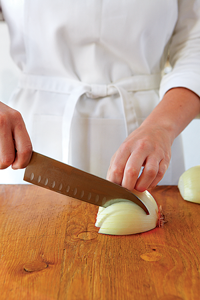
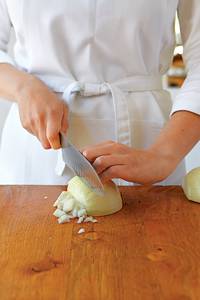
■ Garlic. Sure, you can buy chopped garlic in a jar, but that doesn’t offer optimal flavor. You can make it less time consuming by slicing off the root end, smashing the garlic to remove the papery skin, then slicing the semi-smushed piece of garlic.

■ Knives. The best way to dull a knife is cleaning it in the dishwasher. Washing by hand takes less than 10 seconds. Ideally, you should get your knives professionally sharpened every six months.

“I don’t have time to deal with produce.”
KRISTI HART
Human Resources Director
 VEGGIE UP CHALLENGE: As a working mom with two small children, Kristi is always rushing. She feels like she doesn’t have time during the day to eat many vegetables herself, and she finds it hard to squeeze in dinnertime prep work.
VEGGIE UP CHALLENGE: As a working mom with two small children, Kristi is always rushing. She feels like she doesn’t have time during the day to eat many vegetables herself, and she finds it hard to squeeze in dinnertime prep work.
OUR ADVICE
■ Make salad a staple. Begin each dinner with one: Use no-prep bagged salad greens as a base, then load in other chopped veggies. This can add two servings.
■ Fill up your freezer. Frozen veggies are ideal for getting dinner on the table within minutes. You can steam them in the microwave for a quick cooking option or sauté with fresh herbs for an easy stovetop version.

■ Pay a bit more for fresh precut veggies. You can’t beat the convenience factor—some are even designed to microwave-steam in the bag. You can also spread veggies on a baking sheet to roast.
■ Augment lunch with raw veggies and dip brought from home. (Hint: Get one of those little insulated lunch bags.) For variety, try snow peas, cauliflower, radishes, and cucumber paired with a store-bought tzatziki or hummus.
Instead of bread or tortillas, make your next sandwich or wrap inside a leafy green such as Bibb lettuce, romaine, or red lettuce.

“How do I add in veggies when I’m always eating out?”
MARGARET BARNHART
Sales Manager
 VEGGIE UP CHALLENGE: A third of Margaret’s meals are eaten out due to her hectic work schedule. “It’s the lunches and dinners that get me,” she says. “People say, ‘Let’s order some appetizers!’” And she’s not talking crudités.
VEGGIE UP CHALLENGE: A third of Margaret’s meals are eaten out due to her hectic work schedule. “It’s the lunches and dinners that get me,” she says. “People say, ‘Let’s order some appetizers!’” And she’s not talking crudités.
OUR ADVICE
■ Customize your order. Don’t hesitate to combine two or three appetizers or sides and skip the entrée to fit in your veggies. You can even ask if the kitchen will build a custom veggie plate with three sides.
■ Opt for veggie-based entrées. Look for pasta topped with vegetables, chunky vegetable broth–based soups, veggie-loaded sandwiches, and vegetable pizzas—just ask them to hold half of the cheese.
■ Entertain with ethnic. If clients are willing to try them, Chinese, Thai, Indian, and Mexican eateries offer lots of vegetable-based entrées and side dishes. Even if the table is sharing apps, order a vegetable platter and savor it.
■ Order entrée salads. These salads can provide up to three servings of vegetables—just order dressings on the side so you can control how much you use and monitor rich, calorie-heavy toppings like blue cheese and bacon bits.
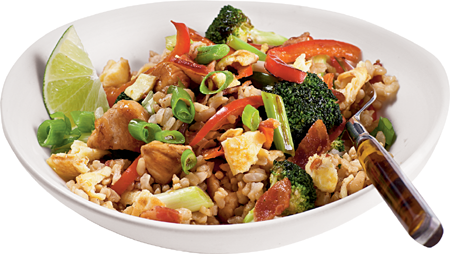
Oatmeal topped with fruit is an easy option for rushed morning meals or when you’re grabbing breakfast from a fast-food restaurant.

“My kids won’t eat their vegetables!”
ROBIN BASHINSKY
Cooking Light Recipe Tester
 VEGGIE UP CHALLENGE: Robin cooks for a living, but when he gets home his kids turn up their noses at the vegetables he puts on their plates. To keep the peace, the kids get one meal and the grown-ups eat later. But by the time they’ve fed the kids and focused on their own meal, Robin and his wife Nan are so wiped out that they end up not eating many vegetables, either. Sound familiar?
VEGGIE UP CHALLENGE: Robin cooks for a living, but when he gets home his kids turn up their noses at the vegetables he puts on their plates. To keep the peace, the kids get one meal and the grown-ups eat later. But by the time they’ve fed the kids and focused on their own meal, Robin and his wife Nan are so wiped out that they end up not eating many vegetables, either. Sound familiar?
OUR ADVICE
■ Involve the kids in shopping. Let each child pick an item for the family to try. Let them grab purple cauliflower or warty celeriac—if it’s a veggie, it doesn’t matter.
■ Let your kids lend a hand. Whether it’s peeling carrots or simply pouring frozen peas into a bowl, if children feel a sense of pride from helping prepare a meal, they’ll be more interested in eating it.
■ Keep it crunchy. How you prep veggies can make all the world of difference for picky kids. Dutch researchers found that children prefer vegetables that are steamed or boiled over mashed, grilled, stir-fried, and deep fried. Veggies that retained their original taste, color, and crunchiness were the most appealing. Noisy, crunchy veggies like raw carrots and bell peppers paired with one of the dips are sure crowd-pleasers.
■ Please all palates with one dish. Serve pan-grilled chicken breasts to kids along with sweet crisp veggies like cucumber sticks or blanched green beans. For the adults, slice and pile the chicken on top of a big bed of spinach or arugula tossed with the same veggies.
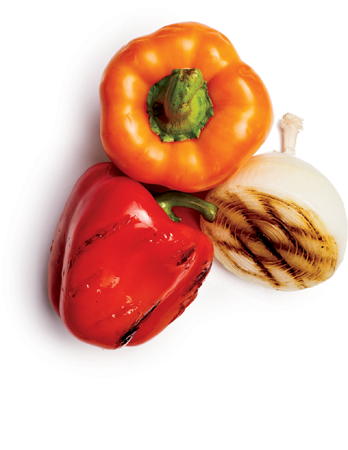
EXPERT TIP: Be a Veggie Role Model

“It’s important to serve some type of vegetable on their plate every day so your kids realize it’s simply part of the meal, and be sure they see you enjoying your own plate of vegetables. Don’t underestimate your influence as a veggie role model.”
—Liz Weiss, MS, RD, and Janice Bissex, MS, RD, bloggers, Meal Makeover Moms’ Kitchen
Zucchini Oven Chips

Preheat oven to 425°. Stir together ¼ cup dry breadcrumbs, ¼ cup grated fresh Parmesan cheese, ¼ teaspoon seasoned salt, and ⅛ teaspoon freshly ground pepper in a medium bowl. Pour 2 tablespoons fat-free milk in a shallow bowl. Dip ¼-inch-thick zucchini slices (about 2 small zucchini) in milk, and dredge in breadcrumb mixture. Place slices on an ovenproof wire rack coated with cooking spray; place rack on a baking sheet. Bake at 425° for 30 minutes, or until browned and crisp. Serve immediately. Serves 4 (serving size: about ¾ cup).
CALORIES 61; FAT 1.9g (sat 1g, mono 0.5g, poly 0.2g); PROTEIN 3.8g; CARB 7.6g; FIBER 1g; CHOL 5mg; IRON 0.6mg; SODIUM 231mg; CALC 87mg
Let your kids help prepare these tasty veggie chips. They can measure, mix, and dredge.
IT’S TRICKY ENOUGH trying to squeeze in a few extra servings of veggies a day without worrying about how to find the freshest produce on the block. Robert Schueller, Cooking Light’s produce guru and director of public relations at Melissa’s Produce, gives a few ideas on what to buy when:

FALL
Potatoes
They’re cheaper in the fall and are the ultimate comfort food—great for thick soups or roasted for a holiday dinner.
Look for: Potatoes that are wrinkle free, without green tinges, sprouts, or cracks
Parsnips
When cooked they have the combined sweetness of a carrot with a taste of parsley and some subtle nuttiness.
Look for: Those that are firm and relatively smooth
Onions
They’re great in fall stews or casseroles, or roasted with olive oil.
Look for: A firm bulb, without soft spots
WINTER
Leafy greens
Fresh greens are available year-round and are so versatile—you can add them to spaghetti, sauté them, or use them as a salad base.
User tip: Don’t wash them until you’re ready to use, since rinsing can break down the protective layer that extends their shelf life.
Winter squash
It brightens up this time of year with its array of colors, from green to yellow to orange, and makes a great add-in to soups and pasta.
Look for: Squash that seems heavy for its size, since it contains more edible flesh
Beets
They’re great in winter soups, or served warm with butter.
User tip: It’s much easier (and much less messy) to peel them when they’re cooked.

Peas
They’re great raw or cooked, or mashed and mixed with avocado to make guacamole.
Look for: Peas with bright green, glossy pods
Artichokes
March through May is peak season. They look tough, but cooking makes them buttery sweet.
Look for: Leaves that squeak when pressed together
Bell peppers
They’re less expensive now, since you can get them domestically.
Look for: Firm peppers with shiny, wrinkle-free skins
SUMMER
Corn
You can’t beat fresh corn in the summer, especially when it comes to its price!
User tip: Pull back portions of the husk to make sure the green silk is slightly sticky.
Tomatoes
They’re a great addition to summer salads, as they pack a wallop of sweetness tinged with a bit of acidity.
Look for: Plump tomatoes that feel heavy for their size
Avocado
You can easily add it to salads or hamburgers at summer barbecues, or even serve up homemade guacamole.
User tip: Push the skin when buying—if it yields slightly, it’s good for slicing or dicing, and if it leaves a small dent, it’s ideal for mashing.
HOW TO BUY ORGANIC
The benefits of a fruit-and veggie-rich diet far outweigh the health risks of pesticide exposure. You can reduce your exposure by choosing organic when purchasing the fruits and vegetables that have the highest levels of pesticide residues—referred to as the Dirty Dozen™. The Clean 15™ includes items that are lowest in pesticide residues. Here’s the list from the non-profit Environmental Working Group’s Shopper’s Guide to Pesticides in Produce:
THE DIRTY DOZEN
Apples
Celery
Sweet bell peppers
Peaches
Strawberries
Nectarines (imported)
Grapes
Spinach
Lettuce
Cucumbers
Blueberries (domestic)
Potatoes
THE CLEAN 15
Onions
Sweet corn
Pineapples
Avocado
Cabbage
Sweet peas
Asparagus
Mangoes
Eggplant
Kiwi
Cantaloupe (domestic)
Sweet potatoes
Grapefruit
Watermelon
Mushrooms
SALADS HAVE THE POTENTIAL to be a healthy habit goldmine, rich in fruits, vegetables, and nutritional value. But we’re not talking about salads with a leaf of iceberg, and loads of bacon, cheese, and ranch. We’re talking beds of dark, leafy greens with colorful, crunchy toppings to provide a wide array of phytonutrients.
Alternate your greens to keep things interesting—for a general rule of thumb, the darker the greens (like spinach, kale, or swiss chard) the more nutrient-rich they are. Pile on healthy toppings like chopped fruit and vegetables, and you can easily get half your daily recommended amount packed into one glorious salad. Don’t cheat yourself on the dressing: A few splashes of a good, heart-healthy canola-or olive oil–based dressing can work wonders.
Honey Balsamic Arugula Salad

2 tablespoons balsamic vinegar
2 tablespoons olive oil
1 tablespoon minced shallots
1 tablespoon chopped fresh parsley
1 teaspoon Dijon mustard
1 teaspoon honey
¼ teaspoon salt
¼ teaspoon freshly ground black pepper
1 garlic clove, crushed
6 cups arugula
¼ cup sliced red onion
2 tablespoons chopped walnuts
1 ounce shaved fresh Parmesan cheese (about ¼ cup)
1. Combine first 9 ingredients in a large bowl; stir well with a whisk. Add arugula, onion, walnuts, and Parmesan; toss gently to coat. Serves 4.
CALORIES 139; FAT 11.2g (sat 2.4g, mono 5.8g, poly 2.6g); PROTEIN 4.1g; CARB 6.4g; FIBER 0.9g; CHOL 5mg; IRON 0.9mg; SODIUM 229mg; CALC 144mg
Shrimp, Avocado, and Grapefruit Salad

Both red and white grapefruit have been shown in studies to lower cholesterol levels.
Shallots are rich in allicin and quercetin, which reduce risk of both heart disease and cancer.
2½ tablespoons olive oil, divided
12 ounces peeled and deveined medium shrimp
½ teaspoon salt, divided
¼ teaspoon freshly ground black pepper, divided
1 grapefruit
2 tablespoons chopped fresh tarragon
2 teaspoons brown sugar
1 teaspoon chopped shallots
6 cups chopped romaine lettuce
1 peeled avocado, cut into 12 wedges
1. Heat a large skillet over medium-high heat. Add 1½ teaspoons oil to pan; swirl to coat. Sprinkle shrimp with ¼ teaspoon salt and ⅛ teaspoon pepper. Add shrimp to pan; cook 3 minutes or until shrimp are done, stirring frequently. Remove from pan; keep warm.
2. Peel and section grapefruit over a bowl, reserving 3 tablespoons juice. Combine grapefruit juice, remaining 2 tablespoons oil, remaining ½ teaspoon salt, remaining ⅛ teaspoon pepper, tarragon, brown sugar, and shallots in a large bowl, stirring well with a whisk. Add lettuce; toss. Arrange 2 cups lettuce mixture on each of 4 plates. Top each serving with 3 avocado wedges; divide shrimp and grapefruit evenly among servings. Serves 4.
Sustainable Choice: Buy U.S. or Canadian wild or farmed shrimp.
CALORIES 291; FAT 17.7g (sat 2.6g, mono 11.3g, poly 2.5g); PROTEIN 19.9g; CARB 15.5g; FIBER 6g; CHOL 129mg; IRON 3.4mg; SODIUM 433mg; CALC 96mg
EXPERT TIP: Open with Salad

“Starting out the meal with a big bowl of greens is not just a way to grab onto nutrients. It’s also a perfect way to put the skids on overeating. Penn State researchers find people who eat salad before a meal end up eating less.”
—Maureen Callahan, MS, RD, nutrition writer
Tired of the same old boring lunchtime side salad? Here’s a way to shake things up: Start with 2 cups of fresh mixed greens, add a tablespoon of your favorite vinaigrette, and then pile on one of these 100-calorie topping combinations.

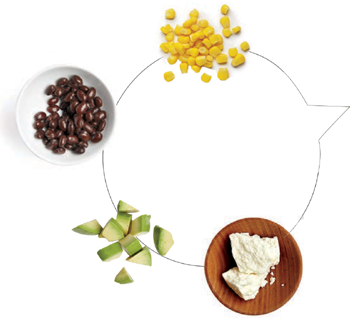
2 tablespoons rinsed and drained black beans + 2 tablespoons sweet yellow corn + 2 tablespoons crumbled queso fresco + 2 tablespoons cubed avocado
CALIFORNIAN

3 tablespoons cubed avocado + 1 center-cut bacon slice, crumbled + 1 tablespoon shredded cheddar cheese

2 tablespoons edamame + 1 tablespoon crunchy Chinese noodles + 2 tablespoons Mandarin orange segments + 1 tablespoon chopped roasted peanuts
NUTS, BERRIES & BLUE
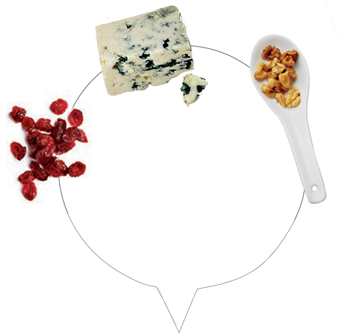
1 tablespoon crumbled blue cheese + 1 tablespoon sweetened dried cranberries + 1 tablespoon chopped toasted walnuts

¼ cup sliced red bell pepper + 2 tablespoons crumbled feta cheese + ¼ cup chopped fresh cucumber + 4 sliced kalamata olives

½ ounce crumbled goat cheese + 1 tablespoon chopped toasted walnuts + ¼ cup fresh pear slices
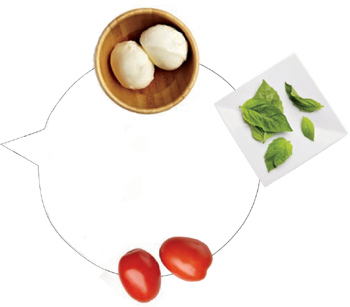
2 plum tomatoes, sliced + 2 tablespoons chopped fresh basil + 1 ounce fresh mozzarella, sliced
MAKE IT A MEAL

Double the greens and dressing, pick your favorite flavor booster, then add extra protein for a super salad supper that clocks in at under 400 calories.
Flank steak–topped salad (3 ounces broiled) 375 calories
Chicken breast–topped salad (3 ounces roasted) 360 calories
Shrimp-topped salad (¼ pound grilled) 345 calories
ROASTING VEGGIES IS A SUREFIRE WAY to win over picky eaters. Unlike boiling, which can leave vegetables limp and soggy, roasting concentrates natural sugars, creating sweet vegetables bursting with flavor. It’s ideal for dense veggies such as potatoes, carrots, and winter squash, as well as high-moisture ones like asparagus and summer squash. There’s no better way to build big, intense flavors with so little effort.
Quick Side
Roasted Potatoes with Thyme and Garlic

Preheat broiler. Combine 1 (20-ounce) package refrigerated potato wedges, 2 tablespoons olive oil, ¼ teaspoon kosher salt, and ¼ teaspoon freshly ground black pepper on a baking sheet. Broil 12 minutes, stirring after 6 minutes. Stir in 1 tablespoon minced garlic; broil 2 minutes or until potatoes are tender. Remove from oven; sprinkle with 2 teaspoons chopped fresh thyme. Serves 4 (serving size: about ¾ cup).
ROAST 1-2-3
1. Cut the veggies into same-sized pieces so that they cook evenly.
2. Place the cut veggies on a baking sheet or roasting pan (for easy cleanup, line the pan with foil and coat with cooking spray), and toss them with a little olive or canola oil or spray with cooking spray. Then sprinkle with kosher salt, freshly ground black pepper, and any additional herbs of your choice. Just remember to spread the veggies in a single layer. If they’re stacked on top of one another, the veggies on the bottom will steam rather than roast.
3. Stick the veggies in the oven and roast until browned. They usually need a moderate temperature near 375° so that the water inside the vegetables evaporates quickly to concentrate the flavor without the exterior browning too deeply or becoming too soft.
CALORIES 151; FAT 6.8g (sat 0.9g, mono 4.9g, poly 0.7g); PROTEIN 3.7g; CARB 18.4g; FIBER 3.6g; CHOL 0mg; IRON 0.8mg; SODIUM 269mg; CALC 6mg
Roasted Asparagus with Browned Butter

1 pound asparagus spears, trimmed
1 tablespoon olive oil
½ teaspoon kosher salt
¼ teaspoon black pepper
1½ tablespoons butter
1½ tablespoons fresh Meyer lemon juice
1½ teaspoons chopped fresh thyme
1 teaspoon grated Meyer lemon rind
1. Preheat oven to 450°. Place asparagus in a roasting pan; drizzle with oil. Sprinkle evenly with salt and pepper. Bake at 450° for 8 minutes or until crisp-tender.
2. Melt butter in a small skillet over medium heat; cook 3 minutes or until lightly browned, shaking pan occasionally. Remove from heat; stir in juice. Drizzle butter mixture over asparagus; toss well to coat. Sprinkle thyme and rind over asparagus. Serves 4 (serving size: about 3 ounces).
CALORIES 82; FAT 7.8g (sat 3.2g, mono 3.6g, poly 0.6g); PROTEIN 1.4g; CARB 3.1g; FIBER 1.4g; CHOL 11mg; IRON 1.4mg; SODIUM 272mg; CALC 19mg
READER TIP: Perfect Your Knife Skills

“Learning to chop vegetables in different ways was huge. Now I can cut matchstick carrots and properly chop an onion. I’ll do one big one and keep it in the fridge for several days. Having onions cut up makes a huge difference to me and cuts down on my prep time for meals. On a day when I was tired, that simple act would stop me from trying a recipe. Now I just pull it out of the fridge and go.
—Mary Lynn Meyer, health-care consultant and Healthy Habits Graduate
Steam to Preserve Flavor and Nutrients
OVERCOOKED VEGETABLES ARE A TURN-OFF. That’s why steaming is ideal, because it cooks food more gently than almost any other method, which means the veggie retains its original texture. And unlike boiling, which leaches water-soluble nutrients from food, steaming keeps most of the nutrients—as well as the flavor and color—intact. Almost all veggies are good candidates, except for spongy ones like mushrooms or eggplant or tough ones like hearty greens. Best of all, you don’t need to add much more than a tablespoon of olive or canola oil and your favorite fresh herbs to bring out the veggies’ natural flavor.
Simple Steamed Broccoli
4 cups broccoli florets
1 tablespoon butter
½ teaspoon grated lemon rind
⅛ teaspoon salt
⅛ teaspoon freshly ground black pepper
1. Steam broccoli 5 minutes or until crisp-tender. Place broccoli in a bowl. Add butter, rind, salt, and pepper; toss until butter melts. Serves 4 (serving size: 1 cup).
CALORIES 46; FAT 3.1g (sat 1.9g, mono 0.8g, poly 0.2g); PROTEIN 2.2g; CARB 3.8g; FIBER 2.2g; CHOL 8mg; IRON 0.7mg; SODIUM 113mg; CALC 36mg
Steamed Sugar Snap Peas
3 cups fresh sugar snap peas
1 tablespoon chopped fresh mint or tarragon
1 tablespoon butter
⅛ teaspoon salt
⅛ teaspoon freshly ground black pepper
1. Steam peas 5 minutes or until crisp-tender; drain. Combine peas, mint, butter, salt, and pepper; toss well. Serves 4 (serving size: 3⁄4 cup).
CALORIES 46; FAT 3g (sat 1.8g, mono 0.8g, poly 0.2g); PROTEIN 1.4g; CARB 3.7g; FIBER 1.3g; CHOL 8mg; IRON 1mg; SODIUM 96mg; CALC 22mg
STEAMING 1-2-3
Steaming requires little more than a pan with a well-fitting lid and a steamer to support the food over the liquid in the pan (most cookware sets come with one).
1. Fill the pan with a few inches of water, and bring to a boil.
2. Place the veggies in the metal steamer, and place in the pan (the boiling water shouldn’t touch the vegetables).
3. Cover and steam until the vegetables are crisp-tender when pierced with a knife. Remember, creating a good seal with the lid is crucial for holding in steam. If the lid doesn’t fit snugly, cover the pan with foil, and then cover it with the lid.

Use tongs or spatulas to remove food from the steamer. Steamed food often retains heat longer because the hot steam has permeated the food.
EXPERT TIP: Add a Vinaigrette to Your Veggies

“Vinaigrettes are not just for salads. Try adding them to cooked vegetables; it really sparkles them up. I also love to drizzle on roasted nut oils paired with a sprinkling of the same nut toasted and a finishing salt. The addition of these oils is a two-fer. The vegetables will not only taste better, so you’ll want to eat more, but you’ll enhance the bioavailability of some of the nutrients in the vegetables.”
—Mollie Katzen, best-selling cookbook author
Steamed Green Beans with Tomato-Garlic Vinaigrette

1 tablespoon white wine vinegar
½ teaspoon Dijon mustard
¼ teaspoon salt
⅛ teaspoon freshly ground black pepper
2 garlic cloves, crushed and minced
1 tablespoon extra-virgin olive oil
½ cup seeded chopped tomato
2 teaspoons chopped fresh thyme
1 pound green beans, trimmed
1. Combine first 5 ingredients in a medium bowl; slowly add oil, whisking to combine. Stir in tomato and thyme; let stand 10 minutes.
2. Steam beans, covered, 7 minutes or until crisp-tender. Cut into 2-inch pieces; add to tomato mixture, tossing gently to coat. Serves 4 (serving size: 3⁄4 cup).
CALORIES 73; FAT 3.6g (sat 0.5g, mono 2.5g, poly 0.5g); PROTEIN 2.4g; CARB 9.8g; FIBER 4.2g; CHOL 0mg; IRON 1.4mg; SODIUM 162mg; CALC 48mg
PRESSED FOR TIME? You can streamline your vegetable cooking with a sauté. This method cooks food quickly over relatively high heat in a minimal amount of fat. The browning achieved lends richness to vegetables, and because the food cooks quickly, the flavor and texture remain intact. A good saucepan is all you need (along with some flavorful, heart-healthy olive oil or canola oil) to get delicious veggies on the table in a matter of minutes.
Quick Side
Smoky Asparagus and Mushroom Sauté

Cook 2 applewood-smoked bacon slices in a large skillet over medium heat until crisp. Remove bacon from pan; crumble. Add 1 tablespoon butter to drippings in pan; swirl to coat. Add 6 ounces quartered fresh morel mushrooms; sauté 4 minutes, stirring occasionally. Stir in 1 pound (1-inch) asparagus pieces, ¼ teaspoon freshly ground black pepper, and ⅛ teaspoon salt; sauté 5 minutes or until asparagus is crisp-tender, stirring occasionally. Remove from heat; sprinkle with bacon and 3 tablespoons chopped ramp greens or fresh chives. Serves 4 (serving size: about 2⁄3 cup).
CALORIES 107; FAT 7.5g (sat 3.6g, mono 1.7g, poly 0.4g); PROTEIN 5.4g; CARB 6.6g; FIBER 2.7g; CHOL 15mg; IRON 2.6mg; SODIUM 212mg; CALC 38mg
SAUTÉ 1-2-3
1. Cut vegetables to a uniform thickness and size to ensure they cook evenly. Veggies shouldn’t be larger than bite-sized, or they run the risk of burning or forming a tough, overly browned outer crust.
2. Heat the pan over medium-high heat for a few minutes, since it needs to be quite hot to cook the food properly.
3. Once the pan is hot, add in the oil—ideally, one that has a high smoke point, such as olive oil (not extra-virgin) or canola oil. Let it heat for 10 to 30 seconds, then add in the veggies. You’ll be done in about 3 minutes.

Broccoli Rabe with Onions and Pine Nuts
1½ pounds broccoli rabe (rapini)
1 tablespoon olive oil
1½ teaspoons butter
1 cup sliced onion
¼ teaspoon salt
2 tablespoons toasted pine nuts
1. Trim broccoli rabe; cut into 3-inch-long pieces. Cook in boiling water 1½ minutes; drain and rinse. Drain well. Heat olive oil and butter in a skillet over medium-high heat. Add onion; sauté 2 minutes or until lightly browned. Add broccoli rabe; sprinkle with salt, and toss to combine. Cook 1 minute. Sprinkle with pine nuts. Serves 4.
CALORIES 132; FAT 7.7g (sat 1.6g, mono 3.6g, poly 1.9g); PROTEIN 6.9g; CARB 11.2g; FIBER 0.6g; CHOL 4mg; IRON 1.8mg; SODIUM 207mg; CALC 88mg
Sautéed Snow Peas
1 tablespoon dark sesame oil
1 pound snow peas, trimmed
1½ tablespoons lower-sodium soy sauce
1 teaspoon sambal oelek (ground fresh chile paste; optional)
1. Heat a large skillet over medium-high heat. Add oil to pan; swirl to coat. Add peas; sauté 3 minutes or until crisp-tender. Remove from heat. Add soy sauce and sambal oelek, if desired. Toss to coat. Serves 4 (serving size: about 1 cup).
CALORIES 101; FAT 3.5g (sat 0.5g, mono 1.5g, poly 1.5g); PROTEIN 3g; CARB 8.6g; FIBER 2.7g; CHOL 0mg; IRON 1mg; SODIUM 160mg; CALC 54mg

Sautéed Carrots with Sage
1 teaspoon butter
1 teaspoon olive oil
1½ cups diagonally sliced carrot
2 tablespoons water
⅛ teaspoon salt
⅛ teaspoon freshly ground black pepper
2 teaspoons small fresh sage leaves
1. Melt butter in a large nonstick skillet over medium heat. Add oil to pan; swirl to coat. Add carrot and 2 tablespoons water. Partially cover pan, and cook 10 minutes or until carrots are almost tender. Add salt and pepper to pan; increase heat to medium-high. Cook 4 minutes or until carrots are tender and lightly browned, stirring frequently. Sprinkle with sage. Serves 2 (serving size: ½ cup).
CALORIES 75; FAT 4.4g (sat 1.5g, mono 2.2g, poly 0.4g); PROTEIN 0.9g; CARB 9g; FIBER 2.6g; CHOL 5mg; IRON 0.3mg; SODIUM 224mg; CALC 35mg
Consider Cruciferous Vegetables
DON’T TURN UP YOUR NOSE at those Brussels sprouts—they contain several natural compounds called glucosinolates that may help lower the risk of cancer. These phytonutrients break down in the body to form isothiocynates, which may help block defective genes linked to tumor growth. Here’s the catch: These disease-fighting compounds are the same sulfur-containing substances that give cruciferous veggies their strong smell and bitter taste. You can coax out their natural sweetness by roasting, or through a light steaming or a quick sauté.
Sautéed Brussels Sprouts with Bacon

These veggies are some of the best cancer fighters in the garden.
3 center-cut bacon slices, finely chopped
1½ cups presliced onion
¼ teaspoon dried thyme
⅓ cup fat-free, lower-sodium chicken broth
1 pound Brussels sprouts, trimmed and halved
1. Heat a large skillet over medium-high heat. Add bacon; cook 7 minutes or until crisp. Remove bacon from pan with a slotted spoon; drain.
2. Add onion and thyme to pan; sauté 3 minutes. Add broth and Brussels sprouts; bring to a boil. Cover and simmer 6 minutes or until crisp-tender. Sprinkle with bacon. Serves 4 (serving size: about 1 cup).
CALORIES 81; FAT 1.5g (sat 0.5g, mono 0.1g, poly 0.2g); PROTEIN 6.1g; CARB 13.7g; FIBER 4.9g; CHOL 4mg; IRON 1.8mg; SODIUM 101mg; CALC 58mg
Steamed Baby Bok Choy with Soy-Ginger Drizzle
1 pound baby bok choy, cut in half lengthwise
1 tablespoon lower-sodium soy sauce
1 tablespoon fresh orange juice
1 teaspoon dark sesame oil
½ teaspoon grated peeled fresh ginger
1. Steam bok choy 5 minutes or until crisp-tender. Combine soy sauce, juice, oil, and ginger; drizzle over bok choy. Serves 4 (serving size: 4 ounces bok choy and about 1¾ teaspoons sauce).
CALORIES 27; FAT 1.4g (sat 0.2g, mono 0.5g, poly 0.6g); PROTEIN 2g; CARB 2.8g; FIBER 1.1g; CHOL 0mg; IRON 0.9mg; SODIUM 171mg; CALC 120mg
Curried Cauliflower with Capers

Curried Cauliflower with Capers
6 cups cauliflower florets (about 1 large head)
¼ cup extra-virgin olive oil, divided
2 teaspoons grated lemon rind
2 tablespoons fresh lemon juice
½ teaspoon curry powder
¼ teaspoon freshly ground black pepper
⅛ teaspoon salt
⅓ cup caperberries, thinly sliced
¼ cup chopped fresh flat-leaf parsley
¼ cup capers, drained
1. Preheat oven to 450°.
2. Combine cauliflower and 1 tablespoon oil on a jelly-roll pan, tossing to coat. Bake at 450° for 30 minutes or until browned, turning once.
3. Combine remaining 3 tablespoons oil, lemon rind, and next 4 ingredients in a large bowl; stir with a whisk. Add roasted cauliflower, caperberries, parsley, and capers to bowl; toss mixture well to combine. Serves 6 (serving size: about 1 cup).
CALORIES 107; FAT 9.5g (sat 1.3g, mono 6.6g, poly 1.2g); PROTEIN 2.1g; CARB 5.3g; FIBER 2.6g; CHOL 0mg; IRON 0.7mg; SODIUM 300mg; CALC 24mg
In addition to their link to cancer prevention, cruciferous vegetables are also rich in fiber, vitamin C, and folate.
IF ZUCCHINI AND YELLOW SUMMER SQUASH are the only members of the squash family that you’re familiar with, it’s time to get introduced to the rest of the brood. Maybe it’s the hard, gnarled skin or the mysterious-sounding names (like kabocha) that are intimidating, but these winter squashes are worth getting to know. Their dark-colored flesh—usually yellow to deep orange—is packed with beta-carotene, a powerful antioxidant. Aim for at least three servings of orange-hued vegetables every week.

Acorn Squash Wedges with Maple-Harissa Glaze
Winter squash gets a little pizzazz with the addition of Moroccan chile paste, harissa. For a variation, replace the harissa with a couple teaspoons of minced canned chipotle chiles in adobo sauce and 1 teaspoon of the adobo sauce from the can.
2 medium acorn squash, each cut into 3 wedges and seeded
Cooking spray
½ teaspoon kosher salt
3 tablespoons maple syrup
1 tablespoon unsalted butter, melted
1 tablespoon water
1½ teaspoons harissa paste
4 teaspoons sesame seeds
1. Preheat oven to 400°. Arrange squash, cut sides up, on a parchment paper–lined baking sheet. Coat squash lightly with cooking spray; sprinkle evenly with salt. Combine syrup, butter, 1 tablespoon water, and harissa in a bowl, stirring well; drizzle evenly into each squash cavity. Bake at 400° for 30 minutes. Sprinkle squash evenly with sesame seeds; bake 20 minutes or until seeds are toasted and squash is tender. Serves 6 (serving size: 1 squash wedge).
CALORIES 113; FAT 3.1g (sat 1.4g, mono 0.9g, poly 0.6g); PROTEIN 1.5g; CARB 22.3g; FIBER 2.4g; CHOL 5mg; IRON 1.5mg; SODIUM 167mg; CALC 75mg
READER TIP: Prepping Veggies

“I prep my veggies as soon as possible after getting home from the store. I blanch green beans and freeze them. I cut the lettuce, and put it in zip-top bags, removing as much air as possible. I cut onions and tomatoes up to two days in advance. Same thing for zucchini and carrots. If you blanch them, they won’t get bad as quickly.”
—Sandrine Berger

1 (2½-pound) butternut squash
Cooking spray
1 tablespoon extra-virgin olive oil
1½ cups chopped onion
3 garlic cloves, minced
6 cups organic vegetable broth
2 cups coarsely chopped peeled Yukon gold potatoes
2 teaspoons chopped fresh sage
¼ teaspoon freshly ground black pepper
1 bay leaf
2 tablespoons chopped fresh parsley
2 teaspoons honey
1. Preheat oven to 400°.
2. Cut squash in half lengthwise; discard seeds. Place squash, cut sides down, on a foil-lined baking sheet coated with cooking spray. Bake at 400° for 30 minutes or until tender. Cool. Discard peel; mash pulp.
3. Heat a Dutch oven over medium-high heat. Add oil to pan; swirl to coat. Add onion; sauté 4 minutes, stirring occasionally. Add garlic; sauté 30 seconds, stirring constantly. Add squash, broth, and next 4 ingredients; bring to a boil. Reduce heat, and simmer 45 minutes or until potato is tender, stirring occasionally. Let stand 10 minutes. Discard bay leaf.
4. Place one-third of vegetable mixture in a blender. Remove center piece of blender lid (to allow steam to escape); secure blender lid on blender. Place a clean towel over opening in blender lid (to avoid splatters). Blend until smooth. Pour into a large bowl. Repeat procedure twice with remaining squash mixture. Return pureed mixture to pan; cook over medium heat 3 minutes or until thoroughly heated. Stir in parsley and honey. Serves 6 (serving size: about 1 cup).
CALORIES 166; FAT 2.7g (sat 0.4g, mono 1.8g, poly 0.3g); PROTEIN 2.9g; CARB 35.1g; FIBER 6.2g; CHOL 0mg; IRON 1.3mg; SODIUM 582mg; CALC 83mg
Quick Side
Preheat broiler. Place 6 (1-ounce) slices French bread baguette in a single layer on a baking sheet. Broil 2 minutes or until toasted. Sprinkle 2 ounces crumbled goat cheese (about ½ cup) evenly over slices; sprinkle evenly with 1 tablespoon finely chopped fresh chives. Serves 6 (serving size: 1 toast).
CALORIES 107; FAT 2.5g (sat 1.5g, mono 0.6g, poly 0.3g); PROTEIN 5.1g; CARB 16.1g; FIBER 0.7g; CHOL 4mg; IRON 1.2mg; SODIUM 219mg; CALC 26mg
Roasted Pumpkin and Sweet Potato Pilaf
2 cups (½-inch) cubed peeled fresh pumpkin (about 12 ounces)
1½ cups (½-inch) cubed peeled sweet potato (about 1 medium)
Cooking spray
2 teaspoons olive oil
1 cup diced onion (1 small)
⅓ cup diced celery (about 1 stalk)
2 teaspoons minced garlic
4 cups fat-free, lower-sodium chicken broth
1 cup brown rice
2 teaspoons chopped fresh sage
½ teaspoon freshly ground black pepper
¼ teaspoon salt
1 bay leaf
1. Preheat oven to 400°.
2. Arrange pumpkin and sweet potato in an even layer on a jelly-roll pan coated with cooking spray. Bake at 400° for 35 minutes or until tender and vegetables just begin to brown, stirring after 18 minutes. Remove from oven, and set aside.
3. Heat a large saucepan over medium-high heat. Add oil to pan; swirl to coat. Add onion, celery, and garlic; sauté 3 minutes or until onion is tender. Add broth and remaining ingredients to onion mixture, stirring to combine; bring to a boil. Cover, reduce heat, and simmer 50 minutes or until rice is done and liquid is mostly absorbed. Remove from heat; discard bay leaf. Add pumpkin mixture; stir gently to combine. Serves 6 (serving size: about ¾ cup).
CALORIES 200; FAT 2.5g (sat 0.4g, mono 1.4g, poly 0.5g); PROTEIN 5.9g; CARB 38.8g; FIBER 3g; CHOL 0mg; IRON 1.3mg; SODIUM 428mg; CALC 45mg
HOW TO PREP PUMPKIN

1. Place pumpkin on a steady surface, stem side up. Use a small knife to cut around the stem, about 2 inches out.

2. Scoop out stringy fibers and seeds; toss the fibers. Rinse and save the seeds to toast.

3. Cut the pumpkin in half using a heavy chef’s knife. Scrape the flesh with a spoon to remove any remaining fibers.
Pumpkin and other winter squash are rich in beta-carotene, along with lutein and zeaxanthin, yellow-pigmented carotenoids that promote eye health.
Indian-Spiced Roasted Squash Soup

1 cup chopped yellow onion
8 ounces carrot, chopped
4 garlic cloves, peeled
1 (1-pound) butternut squash, peeled and cut into ½-inch cubes
1 (8-ounce) acorn squash, quartered
1 tablespoon olive oil
½ teaspoon black pepper
2 cups water
1 teaspoon Madras curry powder
½ teaspoon garam masala
¼ teaspoon ground red pepper
2 (14-ounce) cans fat-free, lower sodium chicken broth
¼ teaspoon kosher salt
6 tablespoons Greek yogurt
6 teaspoons honey
1. Preheat oven to 500°.
2. Arrange first 5 ingredients on a jelly-roll pan. Drizzle with oil; sprinkle with pepper. Toss. Roast at 500° for 30 minutes or until vegetables are tender, turning once. Cool 10 minutes. Peel acorn squash; discard skin.
3. Place vegetable mixture, 2 cups water, curry powder, garam masala, and red pepper in a food processor; pulse to desired consistency. Scrape mixture into a large saucepan over medium heat. Stir in broth; bring to a boil. Cook 10 minutes, stirring occasionally, and stir in salt. Combine yogurt and honey, stirring well. Serve with soup. Serves 6 (serving size: 1 cup soup and 4 teaspoons yogurt mixture).
CALORIES 143; FAT 3.1g (sat 0.7g, mono 1.8g, poly 0.4g); PROTEIN 4.8g; CARB 27g; FIBER 4.4g; CHOL 1mg; IRON 1.5mg; SODIUM 343mg; CALC 98mg
EXPERT TIP: Put Some Soup On

“Soups are among the easiest, most inexpensive, and quickest dishes to make, especially with the bounty of winter vegetables—winter squash, Jerusalem artichokes, potatoes, carrots, parsnips, and mixtures of all those vegetables. They’re healthy, inexpensive, and filling. Plus, you can make a big batch and have leftovers. Soups are always better reheated.”
—Deborah Madison, chef and author of multiple cookbooks, including Vegetarian Cooking for Everyone
BEANS HELP REDUCE THE RISK OF HEART DISEASE, help keep blood sugar in check, and even lower the risk of certain cancers. Best of all, they’re not only veggies, but they’re packed with protein, fiber, and folate and can serve as a satisfying stand-in for meat. They’re quick additions to salads, soups, and entrées, and can even be the spotlight of their own meal. Is there anything they can’t do?
Zesty Three-Bean and Roasted Corn Salad
2½ cups (1-inch) cut green beans(about 1 pound)
¾ cup fresh corn kernels (about 2 medium ears)
¾ cup diced red bell pepper
½ cup minced red onion
¼ cup chopped fresh cilantro
1 tablespoon minced seeded jalapeño
1 (16-ounce) can cannellini beans or other white beans, rinsed and drained
1 (15-ounce) can black beans, rinsed and drained
¼ cup fresh lime juice
¼ cup red wine vinegar
1 tablespoon minced garlic
1 tablespoon olive oil
2 teaspoons ground cumin
1 teaspoon chili powder
½ teaspoon salt
¼ teaspoon red chile sauce
Dash of ground red pepper
1 cup diced seeded tomato (about 2 medium)
1 cup diced avocado
1. Heat a large nonstick skillet over medium-high heat. Add green beans and corn to pan; sauté 3 minutes or until lightly browned. Transfer green bean mixture to a large bowl. Add bell pepper and next 5 ingredients to bowl; toss well. Combine juice, vinegar, and next 7 ingredients in a small bowl; stir with a whisk. Add juice mixture to bean mixture; toss well. Cover and chill 30 minutes. Gently stir in tomato and avocado. Serve immediately. Serves 10 (serving size: about 1 cup).
CALORIES 146; FAT 5.3g (sat 0.6g, mono 3g, poly 0.7g); PROTEIN 6.6g; CARB 23.1g; FIBER 6.9g; CHOL 0mg; IRON 1.7mg; SODIUM 233mg; CALC 64mg
TOP-NOTCH BEANS
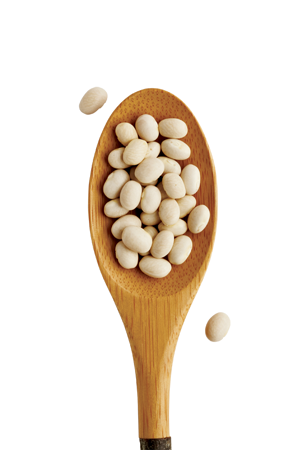
Best in Fiber:
Navy Beans
You’ll get 9.6g of filling fiber in just half a cup, which is a third of the 25 to 30g you need daily. Navy beans edge out black beans (7.5g) and pintos (7.7g) for the high-fiber honor.

Best in Iron:
Soybeans
They have almost twice the iron of other beans (4.5mg per half cup, a quarter of the amount women ages 19 to 50 need) and are one of the few complete proteins the plant world has to offer.

Best in Folate:
Lentils
All legumes have folate, but lentils take the top prize at 179mcg (micrograms) per half cup. That’s close to half of the 400mcg of naturally occurring folate you’re supposed to eat every day.

Edamame adds healthy fats, fiber, potassium, and satiating protein.
1 center-cut bacon slice
1 tablespoon butter
2 cups chopped sweet onion
2 cups fresh corn kernels (about 3 ears)
1 (16-ounce) bag frozen shelled edamame, thawed
2 tablespoons red wine vinegar
½ teaspoon salt
½ teaspoon freshly ground black pepper
½ teaspoon sugar
3 plum tomatoes, coarsely chopped
1 red bell pepper, seeded and coarsely chopped
3 tablespoons torn basil
1. Cook bacon in a nonstick skillet over medium heat until crisp. Remove bacon from pan, reserving 2 teaspoons drippings in pan; coarsely chop bacon.
2. Increase heat to medium-high. Melt butter in drippings in pan. Add onion; sauté 3 minutes, stirring occasionally. Add corn kernels; sauté 3 minutes or until lightly charred. Add edamame, and sauté 3 minutes, stirring occasionally. Stir in vinegar and next 5 ingredients; cook 30 seconds, stirring occasionally. Sprinkle with bacon and basil. Serves 4 (serving size: 1¼ cups).
CALORIES 300; FAT 12.1g (sat 3.3g, mono 3.3g, poly 3.6g); PROTEIN 17.9g; CARB 37.2g; FIBER 10g; CHOL 10mg; IRON 0.9mg; SODIUM 386mg; CALC 28mg
DON’T LET FAT-and calorie-laden sour cream– and mayonnaise-based dips overpower your beautifully arranged vegetable tray. Instead, sub in healthy plant-based dips such as hummus, salsa, and black bean. You’re not only helping your heart and waistline, but you’re also getting an extra serving of veggies.
Traditional Hummus
Prepare and refrigerate a day ahead; let it stand at room temperature 30 minutes before serving.
2 (15.5-ounce) cans no-salt-added chickpeas (garbanzo beans), rinsed and drained
2 garlic cloves, crushed
½ cup water
¼ cup tahini (sesame seed paste)
3 tablespoons fresh lemon juice
2 tablespoons extra-virgin olive oil
¾ teaspoon salt
¼ teaspoon black pepper
Lemon wedge (optional)
1. Place beans and garlic in a food processor; pulse 5 times or until chopped. Add ½ cup water and remaining ingredients; pulse until smooth, scraping down sides as needed. Garnish with lemon wedge, if desired. Serves 26 (serving size: 2 tablespoons).
CALORIES 44; FAT 2.5g (sat 0.3g, mono 1.2g, poly 0.7g); PROTEIN 1.5g; CARB 4.4g; FIBER 0.9g; CHOL 0mg; IRON 0.3mg; SODIUM 74mg; CALC 12mg
Feta-Baked Hummus variation:

Preheat oven to 400°. Combine Traditional Hummus, 2 ounces crumbled feta cheese (about ½ cup), ¼ cup chopped fresh parsley, and ½ teaspoon ground cumin. Transfer mixture to an 8-inch square glass or ceramic baking dish coated with cooking spray. Sprinkle with 2 ounces crumbled feta cheese (about ½ cup). Bake for 25 minutes or until lightly browned. Garnish with small oregano leaves and, if desired, additional feta. Serves 32 (serving size: about 2 tablespoons).
CALORIES 46; FAT 2.8g (sat 0.8g, mono 1.2g, poly 0.6g); PROTEIN 1.8g; CARB 3.8g; FIBER 0.8g; CHOL 3mg; IRON 0.3mg; SODIUM 100mg; CALC 28mg
White Bean and Roasted Garlic Hummus variation:
Since this version calls for roasted garlic, you can just omit the raw crushed garlic cloves from the Traditional Hummus. Preheat oven to 350°. Remove white papery skin from 2 whole garlic heads (do not peel or separate the cloves). Wrap each head separately in foil. Bake for 1 hour; cool 10 minutes. Separate cloves; squeeze to extract garlic pulp. Discard skins. Place garlic pulp, Traditional Hummus, and 1 (15-ounce) can rinsed and drained cannellini beans (or other white beans) in a food processor; pulse 5 times or until chopped. Add ¼ cup water; process until smooth, scraping down sides as needed. Stir in ¾ teaspoon chopped fresh rosemary. Garnish with additional chopped rosemary, if desired. Serves 32 (serving size: about 2½ tablespoons).
CALORIES 45; FAT 2g (sat 0.3g, mono 1g, poly 0.6g); PROTEIN 1.8g; CARB 5.3g; FIBER 1.2g; CHOL 0mg; IRON 0.4mg; SODIUM 81mg; CALC 16mg
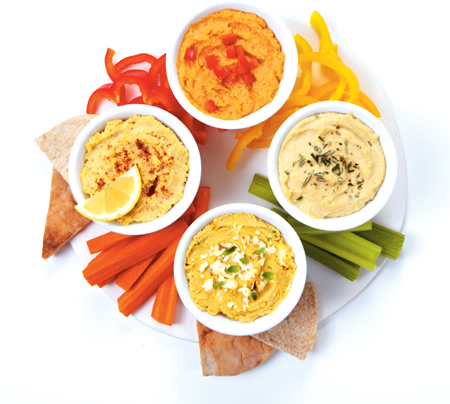
CLOCKWISE FROM TOP: Spicy Red Pepper Hummus, White Bean and Roasted Garlic Hummus, Feta-Baked Hummus, and Traditional Hummus
Spicy Red Pepper Hummus variation:
Preheat broiler. Cut 2 red bell peppers in half lengthwise; discard seeds and membranes. Place pepper halves, skin sides up, on a foil-lined baking sheet; flatten with hand. Broil 15 minutes or until blackened. Place in a paper bag, and fold to close tightly. Let stand 15 minutes. Peel and cut into strips. Place bell peppers, 2 teaspoons sambal oelek (ground fresh chile paste), ½ teaspoon paprika, and ⅛ teaspoon ground red pepper in a food processor; pulse until smooth. Transfer pepper mixture to a serving bowl; stir in Traditional Hummus. Garnish with chopped red bell pepper, if desired. Serves 32 (serving size: about 2 tablespoons).
CALORIES 39; FAT 2g (sat 0.3g, mono 1g, poly 0.6g); PROTEIN 1.4g; CARB 4.3g; FIBER 1g; CHOL 0mg; IRON 0.3mg; SODIUM 74mg; CALC 11mg
 What are your tips for eating more vegetables and fruits?
What are your tips for eating more vegetables and fruits?
“If I buy melon, I cut it up and put it in plastic containers in the fridge. My family always eats more of fruit that’s ready than fruit that needs preparing. If we’re hanging around waiting for dinner to be ready, I’ll put out celery sticks, baby carrots, fennel, and any other cut vegetables to munch on while we’re waiting so that we don’t go into the cheese and crackers routine.”
—Virginia Rotella
Salsa Verde

2 poblano peppers
½ cup fat-free, lower-sodium chicken broth
1 pound tomatillos
2 tablespoons fresh lime juice
2 garlic cloves
⅔ cup chopped white onion
⅓ cup chopped fresh cilantro
½ teaspoon kosher salt
1 fresh serrano chile, finely chopped
1. Preheat broiler.
2. Broil poblano peppers 5 minutes per side or until blackened. Place in a paper bag; fold to close tightly. Let stand 10 minutes; peel and chop. Bring broth and tomatillos to a boil in a saucepan over medium heat. Cover and simmer 8 minutes. Remove from heat; let stand 20 minutes. Pour into a blender. Add lime juice and garlic; process until smooth. Pour into a bowl; stir in poblanos, onion, cilantro, salt, and serrano chile. Chill. Serves 8 (serving size: ¼ cup).
CALORIES 34; FAT 0.7g (sat 0.1g, mono 0.1g, poly 0.3g); PROTEIN 1.3g; CARB 7g; FIBER 1.7g; CHOL 0mg; IRON 0.4mg; SODIUM 146mg; CALC 10mg
Black-Eyed Pea and Tomato Salsa
1 cup chopped tomatoes
¼ cup prechopped red onion
3 tablespoons chopped poblano chile
2 tablespoons chopped fresh cilantro
2 ½ tablespoons fresh lime juice
¼ teaspoon minced fresh garlic
⅛ teaspoon salt
⅛ teaspoon ground cumin
⅛ teaspoon freshly ground black pepper
1 (15.8-ounce) can black-eyed peas, rinsed and drained
1. Place all ingredients in a large bowl, and toss to combine. Serves 8 (serving size: about ⅓ cup).
CALORIES 35; FAT 0.3g (sat 0.1g, mono 0g, poly 0.1g); PROTEIN 1.9g; CARB 6.6g; FIBER 1.5g; CHOL 0mg; IRON 0.4mg; SODIUM 139mg; CALC 11mg
Artichoke, Spinach, and White Bean Dip

THIS IS A RIFF on classic spinach and artichoke dip, only our version uses creamy white beans in place of some of the calorie-and saturated fat–laden cheese.
¼ cup (1 ounce) grated fresh pecorino Romano cheese
¼ cup canola mayonnaise
1 teaspoon fresh lemon juice
¼ teaspoon salt
¼ teaspoon freshly ground black pepper
⅛ teaspoon ground red pepper
2 garlic cloves, minced
1 (15-ounce) can organic white beans, rinsed and drained
1 (14-ounce) can baby artichoke hearts, drained and quartered
1 (9-ounce) package frozen chopped spinach, thawed, drained, and squeezed dry
Cooking spray
½ cup (2 ounces) shredded part-skim mozzarella cheese
1. Preheat oven to 350°.
2. Place first 8 ingredients in a food processor, and process until smooth. Spoon into a medium bowl. Stir in artichokes and spinach. Spoon mixture into a 1-quart glass or ceramic baking dish coated with cooking spray. Sprinkle with ½ cup mozzarella. Bake at 350° for 20 minutes or until bubbly and brown. Serves 12 (serving size: ¼ cup).
CALORIES 87; FAT 5.4g (sat 1.4g, mono 2.3g, poly 1g); PROTEIN 3.7g; CARB 4.9g; FIBER 1g; CHOL 6mg; IRON 0.7mg; SODIUM 232mg; CALC 91mg
READER TIP: Consider Canned

“Canned vegetables can be healthy additions to stews and soups all winter long. Of course, you have to be careful of the sodium and sugar content.”
—Terrie Hull Moeny
FRUITS ARE OFTEN RELEGATED TO BREAKFAST or dessert, but this juicy produce has greater potential. Chop some for your lunchtime salad, create a fruit salsa, roast some for a deliciously simple side, or throw into a veggie-based dish like coleslaw as a surprise add-in.
Quick Side
Pomegranate-Orange Salsa

Pomegranate-Orange Salsa
Combine 1 cup chopped orange sections, ⅔ cup pomegranate seeds (about 2 pomegranates), ⅓ cup fresh pomegranate juice, ¼ cup minced shallots, 2 tablespoons minced jalapeño pepper, 1 tablespoon chopped fresh cilantro, 1 tablespoon fresh lime juice, ¼ teaspoon kosher salt, and ¼ teaspoon freshly ground black pepper. Serves 6 (serving size: ¼ cup).
CALORIES 46; FAT 0g (sat 0g, mono 0g, poly 0g); PROTEIN 0.6g; CARB 11.4g; FIBER 0.8g; CHOL 0mg; IRON 0.2mg; SODIUM 83mg; CALC 18mg
Quick Side
Green Apple Slaw
Combine 2 tablespoons cider vinegar, 1 tablespoon extra-virgin olive oil, 1½ teaspoons sugar, ¼ teaspoon kosher salt, and ¼ teaspoon freshly ground black pepper in a medium bowl; stir until sugar dissolves. Add 3 cups thinly sliced fennel bulb (about 1 large), 2 cups thinly sliced Granny Smith apple (l large), ¼ cup fresh flat-leaf parsley leaves, and ¼ cup slivered red onion; toss to coat. Serves 4 (serving size: about 1 cup).
CALORIES 91; FAT 3.6g (sat 0.5g, mono 2.5g, poly 0.4g); PROTEIN 1.2g; CARB 14.9g; FIBER 3.6g; CHOL 0mg; IRON 0.9mg; SODIUM 155mg; CALC 43mg
1½ teaspoons canola oil
1½ tablespoons minced red onion
1 large garlic clove, minced
2 cups diced fresh pineapple
1 tablespoon lower-sodium soy sauce
1½ teaspoons chopped seeded red jalapeño pepper
1½ teaspoons fresh lime juice
1 teaspoon chopped peeled fresh ginger
1½ teaspoons chopped fresh cilantro
1. Heat a large nonstick skillet over medium heat. Add oil to pan; swirl to coat. Add onion and garlic to pan; cook 2 minutes. Add pineapple; cook 5 minutes or until lightly browned. Add soy sauce, pepper, juice, and ginger; cook 2 minutes. Remove from heat; stir in cilantro. Serves 4 (serving size: about ½ cup).
CALORIES 61; FAT 1.9g (sat 0.1g, mono 1.1g, poly 0.6g); PROTEIN 0.9g; CARB 11.6g; FIBER 1.3g; CHOL 0mg; IRON 0.4mg; SODIUM 135mg; CALC 15mg
Spinach-Strawberry Salad

ADDING FRESH FRUIT to leafy greens lends a colorful and refreshing burst of flavor. You may find that you need less dressing.
1½ cups quartered strawberries
¼ cup Easy Herb Vinaigrette
1 tablespoon finely chopped fresh mint
1 (6-ounce) package fresh baby spinach
2 tablespoons sliced almonds, toasted
¼ teaspoon black pepper
1. Combine first 4 ingredients in a large bowl; toss gently to coat. Sprinkle with almonds and pepper; serve immediately. Serves 4 (serving size: 2 cups).
CALORIES 136; FAT 10.3g (sat 0.7g, mono 6g, poly 3g); PROTEIN 2.1g; CARB 11g; FIBER 3.6g; CHOL 0mg; IRON 1.7mg; SODIUM 113mg; CALC 50mg
READER TIP: Try Freeze-Dried Fruit

“I like to buy freeze-dried fruit at the grocery store. Not dried fruit that has extra sugar and calories added, but the all-natural freeze-dried fruit. It comes in a resealable pouch so it’s supereasy to keep at work and add to yogurt and cereal or just snack on.”
—Stephanie Galvao Barros